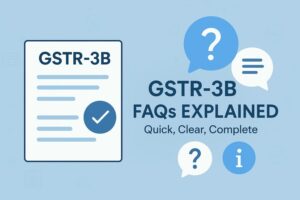Ultimate Guide to Calculating Aggregate Turnover for GST Compliance
- 10 Aug 24
- 14 mins

Ultimate Guide to Calculating Aggregate Turnover for GST Compliance
Key Takeaways
- Understanding and accurately calculating your aggregate turnover is essential for GST compliance and the financial health of your business.
- Aggregate turnover includes all taxable, exempt, and non-taxable supplies, exports, and inter-state transactions, excluding inward supplies on reverse charge and GST itself.
- Your aggregate turnover determines GST registration eligibility, influences eligibility for GST schemes, and impacts the tax rate applicable to your business.
- The Composition Scheme under GST, offering a simplified tax regime, is contingent upon not exceeding a specified aggregate turnover limit.
- Regularly reviewing GST regulations and understanding the implications of aggregate turnover are crucial for adapting to regulatory changes and ensuring ongoing compliance.
In the area of Goods and Services Tax (GST) in India, understanding and accurately calculating your aggregate turnover is not just a compliance requirement—it's essential for the financial health and regulatory adherence of your business. The concept of aggregate turnover under GST encompasses the total value of all taxable and non-taxable supplies, exports, and inter-state transactions conducted by a business across India under a single PAN, excluding inward supplies on which tax is paid under reverse charge and the GST itself.
This metric serves multiple important functions. It determines whether a business needs to register under GST, influences eligibility for various GST schemes, and impacts the tax rate applicable to the business. Given its significance, it's essential for business owners, accountants, and financial professionals to grasp the nuances of calculating aggregate turnover. This not only ensures compliance with India's GST laws but also aids in strategic financial planning and decision-making.
Aggregate Turnover definition by GST Legislation
Under the Goods and Services Tax (GST) framework in India, the concept of "aggregate turnover" plays a pivotal role in determining a business's tax obligations and compliance requirements. The GST legislation defines aggregate turnover as the total value of all taxable supplies, exempt supplies, exports of goods and/or services, and inter-state supplies of a person having the same Permanent Account Number (PAN), across India. It's important to note that this definition excludes the value of inward supplies on which tax is paid by a person on a reverse charge basis, as well as the taxes levied under the GST law itself (such as Central GST, State GST, Union Territory GST, and Integrated GST).
Key Components of Aggregate Turnover
To fully grasp the concept, let's break down the key components included and excluded in the calculation of aggregate turnover:
- Taxable Supplies: These are supplies of goods and services that are chargeable to GST. The value of these supplies is included in the aggregate turnover.
- Exempt Supplies: Supplies that are exempt from GST, including goods or services for which tax is not payable and those specifically exempted by a notification or kept out of the GST ambit, also form part of the aggregate turnover.
- Exports of Goods and/or Services: The total value of goods and services exported outside India is included in the aggregate turnover. Exports of services and goods are treated as zero-rated supplies under GST, meaning exporters can claim refunds on the tax paid on inputs.
- Interstate Supplies: The value of supplies made from one state to another is included in the aggregate turnover. These are subject to Integrated GST (IGST).
Exclusions from Aggregate Turnover
Certain items are explicitly excluded from the calculation of aggregate turnover:
- Inward Supplies on Reverse Charge: The value of supplies on which the recipient is required to pay tax under the reverse charge mechanism (RCM) is not included in the aggregate turnover of the supplier.
- Taxes under GST: Central GST, State GST, Union Territory GST, and Integrated GST are not included in the aggregate turnover.
The Role of Aggregate Turnover in GST
In the Goods and Services Tax (GST) system, the concept of aggregate turnover is not just a measure of a business's financial scale but a crucial determinant for various regulatory requirements and benefits. This comprehensive figure influences a range of GST obligations, from registration to tax payments and filing frequencies. Understanding its role can greatly influence how a business operates within the GST framework, ensuring compliance and optimizing for tax efficiency.
Determining GST Registration Eligibility

One of the primary roles of aggregate turnover is to determine whether a business needs to register under GST. The GST law mandates registration for businesses whose turnover exceeds a certain threshold. This threshold varies, with a higher limit for goods and a lower one for services, and is further adjusted for businesses operating in special category states. By calculating their aggregate turnover, businesses can ascertain their registration obligations, thereby avoiding penalties for non-compliance.
Eligibility for the Composition Scheme

The Composition Scheme under GST offers a simplified tax regime for small taxpayers, allowing them to pay GST at a fixed rate of their turnover and simplifying their compliance procedures. However, eligibility for this scheme is contingent upon the business's aggregate turnover not exceeding a specified limit. This scheme is particularly beneficial for small and medium enterprises (SMEs) as it reduces their tax burden and compliance costs.
Compliance and Filing Requirements
Aggregate turnover also determines the compliance requirements a business must follow, including the frequency of GST returns filings. Businesses with a higher turnover are required to file returns more frequently, whereas smaller businesses benefit from lesser compliance requirements. This tiered approach ensures that the compliance burden is proportionate to the size and capacity of the business.
Input Tax Credit (ITC) Eligibility
While aggregate turnover itself does not directly influence eligibility for Input Tax Credit, it impacts the compliance and reporting mechanisms that ensure smooth ITC claims. Businesses with accurate and timely compliance, facilitated by understanding their aggregate turnover, face fewer hurdles in claiming ITC, thereby improving their cash flows and reducing the cost of inputs.
Why Annual Aggregate Turnover Matters?
Annual aggregate turnover is not just a snapshot of a business's scale but a dynamic metric that can influence strategic decisions and operational efficiencies. Here’s why it matters significantly:
- Strategic Planning and Decision Making: Knowing the annual aggregate turnover helps businesses in strategic planning and making informed decisions regarding expansion, diversification, or contraction of their operations. It aids in assessing the viability of entering new markets or investing in new product lines in the context of GST implications.
- Tax Liability and Cash Flow Management: Understanding the implications of aggregate turnover on tax liability enables businesses to better manage their cash flows. By anticipating their tax obligations, businesses can allocate resources more efficiently, ensuring that they are not caught off guard by unexpected tax demands.
- Negotiating the GST Thresholds: For businesses on the cusp of the GST registration threshold, understanding their aggregate turnover is crucial. It allows them to make informed decisions about their operations to either stay below the threshold and avoid GST registration or to embrace the benefits and responsibilities that come with exceeding the threshold.
- Adaptability to Regulatory Changes: The GST framework is subject to periodic updates and changes. A firm grasp of how aggregate turnover is calculated and its implications allows businesses to quickly adapt to regulatory changes, ensuring ongoing compliance and minimizing disruptions to their operations.
In conclusion, aggregate turnover plays a crucial role in the GST regime, influencing nearly every aspect of a business's tax-related obligations and benefits. A clear understanding of its role and implications is essential for effective tax planning, compliance, and strategic financial management.
How to Compute Aggregate Turnover for GST Enrollment?
Calculating your aggregate turnover is a critical step for GST enrollment. This figure not only determines whether you need to register under the GST regime but also impacts your eligibility for various schemes and compliance requirements. Here’s a step-by-step guide to help you accurately compute your aggregate turnover for GST purposes.
Step 1: Understand the Components of Aggregate Annual Turnover
First, it's essential to know what to include in your calculation. Aggregate Annual turnover comprises the total value of all:
- Taxable Supplies: Sales of goods and services that are liable to GST.
- Exempt Supplies: Sales of goods and services that are exempt from GST.
- Non-GST Supplies: Sales of goods and services that are outside the purview of GST.
- Exports: Goods and services sold to locations outside India, treated as zero-rated supplies under GST.
- Inter-State Supplies: Supplies made from one state to another within India.
Remember, aggregate turnover is calculated on an all-India basis, covering all business operations under the same PAN.
Step 2: Exclude Certain Transactions
While aggregating your turnover, ensure you exclude:
- Inward Supplies on Reverse Charge: Purchases on which you pay GST directly to the government under the reverse charge mechanism.
- Taxes Paid under GST: Central GST, State GST, Integrated GST, and Cess should not be included in the turnover.
Step 3: Aggregate Your Turnover Across All States
Since aggregate turnover includes all transactions under the same PAN, you must sum up the turnovers from all states and union territories where you operate. This is crucial for businesses with operations in multiple locations.
Step 4: Use Financial Records
Rely on your financial records and sales data to compile the necessary figures. Ensure that your records are up-to-date and accurately reflect all your business transactions across the country.
Step 5: Calculate the Total
Add up the value of all taxable, exempt, non-GST, and export supplies, plus the inter-state supplies, excluding the inward supplies on reverse charge and GST paid. This sum represents your aggregate taxable turnover.
Example Calculation:
Let's say your business has the following transactions in a financial year:
- Taxable supplies: ₹10,00,000
- Exempt supplies: ₹2,00,000
- Exports: ₹3,00,000
- Inter-state supplies: ₹5,00,000
- Inward supplies under reverse charge: ₹1,00,000 (Exclude)
- GST paid: ₹1,20,000 (Exclude)
Your aggregate taxable turnover would be: ₹10,00,000 (Taxable) + ₹2,00,000 (Exempt) + ₹3,00,000 (Exports) + ₹5,00,000 (Inter-state) = ₹20,00,000.
Step 6: Review GST Thresholds
After calculating your aggregate turnover, compare it against the current GST registration thresholds. These thresholds vary for goods and services and may be different for special category states. If your turnover exceeds the threshold applicable to your business, you are required to register for GST.
Exploring the Concept of State-wise Turnover
Understanding state-wise turnover is crucial for businesses operating in multiple states under the Goods and Services Tax (GST) regime in India. This concept helps in determining GST liabilities and compliance requirements on a state-by-state basis. Let's delve into how to calculate state-wise turnover and explore its implications through case studies in both normal and special category states.
Case Study: Calculating Turnover in Normal Category States for GST

Scenario: ABC Enterprises operates in Maharashtra and Gujarat, selling both taxable and exempt products. In the financial year, the company reports the following:
- Maharashtra: Taxable sales of ₹5,00,000 and exempt sales of ₹1,00,000.
- Gujarat: Taxable sales of ₹4,00,000 and exempt sales of ₹50,000.
Calculation:
To calculate the state-wise turnover for GST in Maharashtra and Gujarat, ABC Enterprises would sum up both taxable and exempt sales in each state.
- Maharashtra turnover: ₹5,00,000 (Taxable) + ₹1,00,000 (Exempt) = ₹6,00,000
- Gujarat turnover: ₹4,00,000 (Taxable) + ₹50,000 (Exempt) = ₹4,50,000
Implications: Since both turnovers are below the GST registration threshold for normal category states, ABC Enterprises must check if voluntary registration or other state-specific rules might affect their compliance strategy.
💡If you want to pay your GST with your Credit card, then download Pice Business Payment app. The app allows you to pay all business expense such as GST, utility, rent, vendors and much more with your credit card.
Case Study: Assessing Turnover in Special Category States for GST
Scenario: XYZ Handicrafts operates in Assam and Manipur, specializing in goods exempt from GST but also sells taxable items. During the same period, their sales were:
- Assam: Taxable sales of ₹8,00,000 and exempt sales of ₹2,00,000.
- Manipur: Taxable sales of ₹2,00,000 and exempt sales of ₹1,00,000.
Calculation:
For special category states like Assam and Manipur, XYZ Handicrafts calculates its state-wise turnover by adding taxable and exempt sales.
- Assam turnover: ₹8,00,000 (Taxable) + ₹2,00,000 (Exempt) = ₹10,00,000
- Manipur turnover: ₹2,00,000 (Taxable) + ₹1,00,000 (Exempt) = ₹3,00,000
Implications: Given the lower GST registration thresholds in special category states, XYZ Handicrafts must register for GST in Assam. However, in Manipur, they remain below the threshold but should monitor their turnover closely for any changes.
Navigating References to Aggregate Turnover Within GST Regulations
Understanding how aggregate turnover is referenced within GST regulations is key to compliance. The GST law encompasses various provisions where aggregate turnover is used to determine eligibility for registration, compliance requirements, and benefits under different schemes. Businesses must regularly review these regulations, as thresholds and conditions can change based on policy updates.
Key Points to Remember:
- Aggregate vs. State-wise Turnover: Aggregate turnover considers the pan-India basis operations of a business, while state-wise turnover focuses on transactions within a specific state. Both are important for determining GST obligations.
- Special Category States: These states have different thresholds for GST registration and compliance, often lower than those for normal category states. Businesses operating in these regions need to be particularly vigilant in tracking their turnover.
- Regular Updates: GST regulations and thresholds are subject to change. Businesses should stay informed about any updates to ensure ongoing compliance.
 By
By 

















